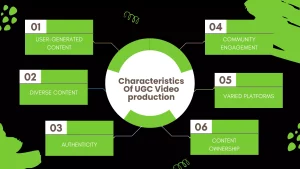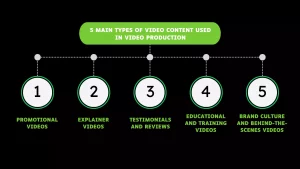5 Main Types Of Video Used In Video Production?
The video has emerged as the undisputed king of content. Whether captivating a global audience or sharing a brand’s story, video production for marketing has become an essential tool in the modern marketer’s arsenal. But question here is since there are many types of videos that we can use for video production, which would be the best for us to continue with.
From social media to website landing pages, from product launches to customer testimonials, video has the power to engage, inspire, and drive action like no other medium.
But what exactly does it take to create compelling video content that resonates with your target audience?
In this blog, we’ll understand the fascinating world of video production for marketing, uncovering the strategies, techniques, and creative innovations that enable businesses to stand out in the digital realm.
Whether you’re a seasoned marketer or just beginning your journey into the world of video, join us as we explore the art and science of crafting videos that leave a lasting impact and drive results.
What is Video Production For Marketing?
Video production for marketing is the process of creating video content with the specific goal of promoting a product, service, brand, or message to a target audience.
It involves the planning, shooting, editing, and distributing videos designed to engage, inform, and persuade viewers to take a desired action, such as purchasing, subscribing to a channel, or sharing content. This is called creating UGC video production.
UGC Video Production
UGC (User-Generated Content) video production refers to creating content generated and contributed by users or community members rather than professional videographers or content creators. UGC video production leverages the creativity and participation of the audience to create authentic and diverse video content.
Key characteristics of UGC video production include:

- User-Generated Content: UGC videos are typically created by individuals who are not professional videographers interested in sharing their experiences, opinions, or talents.
- Diverse Content: UGC videos can cover various topics and styles, from personal vlogs and product reviews to tutorials, testimonials, and creative content.
- Authenticity: UGC videos often come across as more authentic and relatable because they are created by real people with genuine experiences and perspectives.
- Community Engagement: UGC encourages audience engagement and participation, fostering community and interactivity among viewers.
- Varied Platforms: UGC videos can be found on various platforms, including social media, video-sharing websites, forums, and niche communities.
- Content Ownership: Users retain ownership of their UGC but may grant permission for brands or organisations to use their content in marketing campaigns.
UGC video production can be a valuable strategy for brands and organisations looking to harness the power of user-generated content for marketing, brand promotion, or community building. It allows for a more organic and interactive connection with the audience, tapping into the creativity and enthusiasm of users to create meaningful video content.
5 Main Types Of Video Content Used In Video Production.
Here are five main forms of video content that can be commonly used in video production, each serving distinct purposes:

- 1. Promotional Videos:
- Purpose: Promotional videos are created to market and promote a product, service, brand, or event. They aim to generate interest, boost sales, and increase brand visibility.
- Key Features: Promotional videos typically showcase the product’s features, benefits, and unique selling points (USPs). They often incorporate storytelling, emotion, and persuasion to engage viewers.
- Examples include product launches, brand introduction, and event promotion videos. One Indian brand that has garnered attention for its excellent promotional videos is Featherlite.
- Featherlite is a renowned furniture manufacturing company in India, specialising in office furniture and workspace solutions. They have consistently produced high-quality promotional videos that showcase their products and brand identity.
- Featherlite’s promotional videos effectively convey its products’ value and commitment to creating ergonomic and stylish office environments. They are an excellent example of how an Indian brand can leverage video marketing to connect with its target audience and showcase its offerings visually and informatively.
- 2. Explainer Videos:
- Purpose: Explainer videos are designed to simplify complex concepts, processes, or products. They help viewers understand a topic or solution quickly and effectively.
- Key Features: These videos convey information through clear and concise language, visuals, and animations. They often answer common questions or address the target audience’s pain points.
- Examples: How-to videos, tutorial videos, and software demo videos. BYJU’S – The Learning App is an Indian brand known for producing exceptional explainer videos. As an ed-tech company offering online learning solutions, BYJU’S has mastered simplifying complex educational concepts and engaging students through their explainer videos.
BYJU’s explainer videos illustrate how educational content can be made engaging, accessible, and interactive through thoughtful video production. They cater to a diverse group of learners, contributing significantly to the evolution of online education in India.
- 3. Testimonials and Reviews:
- Purpose: Testimonial and review videos showcase the positive experiences of satisfied customers, clients, or influential figures. They build trust, credibility, and social proof.
- Key Features: These videos feature authentic, real-life accounts of individuals who have benefited from the product or service. They may include before-and-after comparisons or interviews.
- Examples: Customer testimonial videos, influencer endorsements, and case study videos. An Indian brand that has effectively used testimonial videos in its marketing strategy is MakeMyTrip, one of the country’s leading online travel companies. MakeMyTrip’s testimonial videos feature customers sharing their travel experiences and how the brand’s services have enhanced their journeys.
- MakeMyTrip’s use of testimonial videos effectively leverages the experiences and voices of real travellers to build trust and inspire others to choose their platform for travel bookings. These videos play a significant role in showcasing the brand’s reliability and the memorable journeys it facilitates for its customers.
- 4. Educational and Training Videos:
- Purpose: Educational and training videos educate, inform, or train viewers on a specific topic, skill, or subject matter.
- Key Features: These videos are structured to deliver structured information or knowledge. They often include visual aids, graphics, and demonstrations to enhance understanding.
- Examples: Online courses, training modules, and academic lectures. An excellent example of an Indian brand that excels in creating educational and training videos is Unacademy. Unacademy is one of India’s largest online learning platforms, offering various educational content, courses, and coaching for competitive exams.
- Unacademy’s commitment to providing high-quality educational content through video production has transformed how students prepare for competitive exams in India. Their videos offer a flexible and accessible learning experience, making education more inclusive and effective for millions of learners nationwide.
- 5. Brand Culture and Behind-the-Scenes Videos:
- Purpose: These videos provide insight into a company’s culture, values, and day-to-day operations. They humanise the brand and create a connection with the audience.
- Key Features: Behind-the-scenes videos often showcase employees, company events, office spaces, or the production process. They emphasise authenticity and transparency.
- Examples include employee spotlight, office tour, and company culture videos.An Indian brand that has effectively used Brand Culture and Behind-the-Scenes videos in its marketing strategy is Tata Motors, one of the country’s largest automobile manufacturers.
- Tata Motors’ Brand Culture and Behind-the-Scenes videos offer viewers a glimpse into the company’s values, innovation, and production processes.
- These videos foster transparency, trust, and brand loyalty by allowing customers and enthusiasts to connect with Tata Motors more personally. They also emphasise the brand’s commitment to quality, innovation, and social responsibility, making Tata Motors a standout example of using Brand Culture and Behind-the-Scenes videos effectively in marketing.
Also Read : What is Video Production? Complete Process of Video Production
Conclusion
The world of video production is a dynamic realm where creativity, storytelling, and technical finesse converge to captivate audiences and convey resonant messages. The possibilities are boundless, from promotional videos that ignite brand excitement to educational content that empowers and enlightens.
As you embark on your video production journey, remember that success lies in a well-crafted narrative, compelling visuals, and a keen understanding of your target audience. Should you seek expert guidance or assistance navigating this captivating terrain, please contact us at hello[at]noboruworld.com or book a call. Let’s create remarkable videos together that leave a lasting impact!
FAQ
How can I incorporate augmented reality (AR) or virtual reality (VR) into my video production?
Integrating AR or VR into video production requires specialized equipment and expertise. It can be used for immersive storytelling, product demonstrations, or virtual tours. Consult with AR/VR specialists and plan your content accordingly to leverage these technologies effectively.
What ethical considerations are when using AI-generated voice overs technology in videos?
AI-generated voice overs technology can be powerful tools, but they also raise ethical concerns about misrepresentation and privacy. Be transparent about their use, especially in commercial or informational content, and consider the potential impact on trust and authenticity.
How can I optimise video content for accessibility, especially for viewers with disabilities?
Accessibility is crucial. Provide closed captions or subtitles for the hearing impaired, audio descriptions for the visually impaired, and ensure colour contrasts for those with visual impairments. Use accessible video players and secure your website or platform complies with accessibility standards like WCAG (Web Content Accessibility Guidelines).



